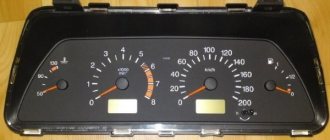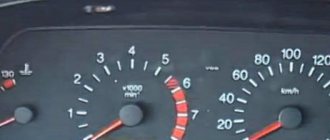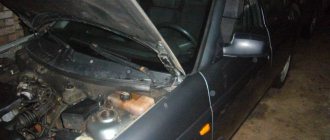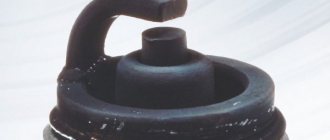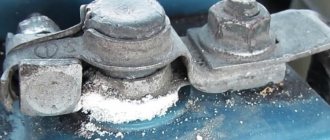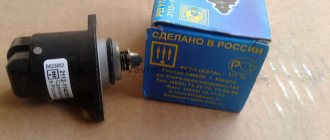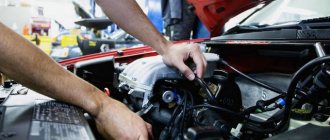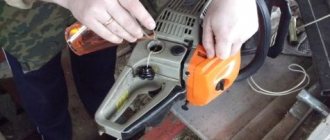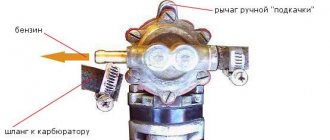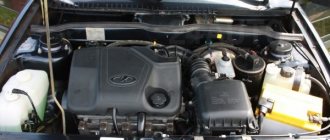Why does the Niva stall at idle (main reasons)
The Niva stalled immediately after starting, why?
Almost always, if a Niva car does not idle and stalls, the reason for this is contamination of parts, for example:
- The throttle valve, injector or carburetor is clogged.
- The idle relay has failed.
- The idle jets are dirty.
- The fuel pump is dirty.
- The engine ventilation system is clogged.
The car stalls after turning off the starter
A dirty throttle valve is to blame!
It happens that the car does not want to slow down the engine speed when you release the gas pedal or stalls at idle. Basically, the problem here lies in a clogged throttle valve. It might just jam.
This problem can happen if you constantly drive on low-quality gasoline. The damper can become clogged when contaminated air enters.
The problem can be corrected by cleaning the damper . To do this, you need to use a regular carburetor cleaner. It is sold in the store.
You should also pay attention to the clogging of the oil trap in the engine crankcase. In this case, the engine will suffocate from excess gases from the crankcase. As a result, it will not hold idle speed and stall. To eliminate the problem, you should regularly wash the crankcase ventilation filter.
The engine stalls immediately, but then starts
Idle speed regulator.
Here the reason may be in the firmware of the electronic engine control unit. The reason for this may be improperly performed tuning of the power unit. In this case, the engine will operate stably only at high speeds. If they drop below 1,000 rpm, the engine will simply stall. This malfunction can be eliminated by flashing the unit to the factory version of the program.
You should also pay attention to all kinds of sensors in car systems. These are, for example, the idle speed control, the throttle position sensor and others. They need to be checked at stands.
The carburetor is Niva’s problem
Inspection and disassembly of the carburetor.
If a carburetor , then in 4 cases out of 5 it can be the cause of unstable engine operation. The most common problem is that the carburetor is clogged. Although this unit is considered reliable in a car, it should also be cleaned periodically. It must be washed using special solvents that are sold in the store.
Carburetor contamination
The main enemy of the carburetor is low-quality fuel . Dirt and moisture can also get there from the tank. Therefore, it is recommended to regularly change the fuel filter, which is installed in front of the carburetor.
The fuel pump should be cleaned periodically. A mesh is installed on it, which traps debris.
Poor quality or old hoses through which fuel enters the tank are another reason for carburetor clogging. Such parts need to be changed every 10–15 years.
Fuel jet
It should be checked when the car stalls at idle. To check, you need to turn on the ignition and reset the wire from the EMC and reconnect it. A click should be heard. When it is not there, you should check whether voltage is supplied to it. In some cases, you will have to completely replace the part.
Other reasons
Reasons not directly related to the condition of the engine control and regulation systems may include problems with air supply systems, exhaust gas outlet systems, and fuel quality.
The condition of the intake system is affected by the conditions in which the vehicle is operated. When driving in dusty areas, the air filters should be replaced more often than the manufacturer recommends.
When the filter is “clogged,” the combustible mixture in the engine combustion chambers becomes depleted. Incomplete combustion of fuel occurs, or, as they say, the engine overflows. Soot forms on the spark plugs and the traction characteristics of the engine deteriorate.
If during operation the fastening of the intake system elements becomes loose, air leaks occur, exhaust gas recirculation systems do not work properly, the fuel mixture becomes lean due to excess air, and the engine does not develop full power. In this situation, it is necessary to check the condition of the fastening of the intake manifold and carburetor.
Exhaust system
Attention! If the car has a catalyst, then start checking the exhaust system with it. Check the condition of the lambda probe, the condition of the catalyst, whether it is “clogged” (due to poor quality fuel, carbon deposits may form on it). If the catalyst is faulty, exhaust gases will not completely exit the cylinders, which will lead to poor filling of the combustion chambers with the air-fuel mixture and a decrease in engine power.
If the seal of the exhaust manifold to the cylinder block is broken, exhaust gases will leak into the engine compartment, which can lead to engine overheating and incorrect operation of electronic systems. This problem can be corrected by tightening the manifold or replacing the gaskets under the intake manifold.
The engine spark plugs will tell you about bad fuel: if there is a red coating on the spark plug contacts and the “skirt” of the central electrode, then the fuel is good. Black carbon deposits on the spark plug indicate low quality fuel with a high content of impurities. The presence of soot impairs the quality of the spark plug.
Sometimes drivers say: the engine pulls poorly, the car does not reach maximum speed. Where to look for reasons? There may be several of them: - severe overheating of the engine; - faulty ignition system: the ignition setting is broken (ignition is too early or late); the centrifugal ignition timing regulator has become stuck; there is a malfunction in the vacuum ignition timing regulator; - insufficient filling of the cylinders with the working mixture; - interruptions in engine operation; - loss of compression in the cylinders; - entry of a lean working mixture into the cylinders.
If the engine does not develop full power, then it is best to check the serviceability of the ignition system. Note that if the ignition is too late, the engine loses throttle response and overheats. A significant reduction in power occurs due to the fact that the mixture does not have time to burn at the moment when the piston is in. m.t.
The combustion of the mixture continues as the piston moves downward; this is easy to determine by touching the exhaust manifold with your hand. It will be too hot because some of the mixture will burn when released. Too early ignition also has a harmful effect on engine operation, when the combustible mixture ignites prematurely and the force of the gases acts towards the piston, which moves towards the engine. m.t.
Also interesting: How to correctly perform chip tuning of a Niva engine
At the same time, frequent and loud metallic knocks are heard in the engine, the engine is prone to fuel detonation, does not work well at low speeds, and sometimes backfires when starting with the crank. Having established that power is lost due to ignition being too early or late, adjust it.
If it is not possible to achieve the desired results by adjusting the ignition timing, it means that there is a malfunction in the automatic ignition timing adjustment devices; centrifugal or vacuum regulators. It must be remembered that the centrifugal regulator regulates ignition timing only depending on the engine speed.
It usually starts working at 400-600 engine rpm. If malfunctions occur in the centrifugal regulator (weakening of the springs or sticking of weights), this will lead to disruption of the ignition timing. If the regulator weights jam, the ignition timing will remain the same at both low and high speeds.
Meanwhile, for high speeds, the ignition timing should be earlier. Late ignition at high speeds will cause a decrease in power and increase fuel consumption. If the regulator springs are weakened and the weights disperse completely, then even at low speeds there will be a large ignition advance, which will also lead to excessive fuel consumption and a decrease in power.
Usually the serviceability of the centrifugal regulator is checked using a synchronograph. But, as a rule, there are no instruments on the way. However, the operation of the centrifugal regulator can still be checked. How it's done? Without removing the distributor from the engine, you need to move the breaker lever and turn the cam by hand in the direction of rotation of the shaft until it stops.
The weights are moving apart. Release the cam and it will return to its original position under the force of the weight springs. If jamming is detected, it must be eliminated and the weakened springs replaced with new ones. From the above it is clear that the centrifugal regulator regulates the ignition timing only depending on the speed.
But on the way, the car has to move along different roads - flat and with inclines. Let us assume that when driving at a constant speed both on a flat road and on an uphill road, the centrifugal regulator will only provide the same ignition timing. While the engine load and throttle opening are significantly greater when driving on an uphill road, the ignition timing should be less than on a flat road when driving at the same speed.
The ignition timing is adjusted when the throttle opening (engine load) changes by a vacuum regulator. It may have the following malfunctions: - loss of spring elasticity; - air leakage into the spring plane; - jamming of the ball bearing of the breaker panel. When the vacuum regulator spring is weakened, at low and medium loads the ignition timing increases.
If air is sucked into the cavity where the spring is located (if the diaphragm is damaged), then the ignition timing will decrease at low loads. If there is too much air leakage, the vacuum regulator does not work at all. The vacuum regulator may also fail due to a stuck ball bearing on the breaker panel.
Like a centrifugal regulator, a vacuum regulator is usually checked for serviceability using a synchronograph. On the way, you can check it in the simplest way: rock the breaker panel on the bearing and make sure there is no excessive clearance, and also determine whether there is an increase in the gap between the panel finger and the diaphragm rod, and whether the rod itself is jumping off.
If you create a vacuum in the vacuum regulator tube disconnected from the carburetor, then if it is in good condition, the breaker panel should turn in the opposite direction of rotation of the cam. Having discovered that both advance angle regulators are working properly and the ignition is set correctly, the reason for the decrease in power must be sought in insufficient filling of the cylinders with the working mixture.
This may be caused by the throttle valve sticking on the axle (not opening it completely). You should check the throttle valve drive and, if necessary, remove jamming and clean the axle. Then make sure the air filter is working properly. If it is dirty, disassemble it, wash it and, if necessary, change the oil.
It is advisable to check the serviceability of the valves and springs of the gas distribution mechanism; in case of violation of the gaps or breakage (loss of elasticity) of the valve springs, weak and broken springs should be replaced, the gap should be adjusted. Insufficient filling of the cylinders with the working mixture can occur when the needle valve of the float chamber is stuck, a faulty muffler, the use of the wrong grade of fuel, as well as in the case of a large deposits of tar and coke in the intake pipe.
Also interesting: Various options for tuning the Niva 21213 and 21214 engine
A common cause of incomplete engine power is the entry of a lean mixture into the cylinders. Reasons for the formation of a lean mixture: - the jets and channels in the carburetor are clogged, contamination (water freezing) of the fuel lines in the power system has occurred. Rinse and blow out the jets and channels, blow out dirty fuel pipes, and if necessary, clean them with wire; - stuck fuel pump valves or clogged sump mesh, a small rupture of the diaphragm.
First, eliminate the jamming of the fuel pump valves, wash the filter element and mesh, and replace the torn diaphragm with a new one or restore the functionality of the old diaphragm in the manner described earlier; - air leaks at the junction of carburetor parts, the carburetor flange with the intake pipe, the intake pipe flanges with the cylinder block due to loosening of fastenings, as well as damage to gaskets.
You can find the location of the leak using a match or soap foam. The flame of a match, brought to the intended place of suction, is deflected towards the gap, and a window is formed in the soap foam. Air leaks are eliminated by tightening the nuts or bolts, as well as replacing the corresponding sealing gaskets; - wear of the fuel pump drive lever, clogging of the air holes of the fuel tank filler plug, jamming of the air damper.
These defects are eliminated as follows: faulty parts of the fuel pump are replaced with new ones, the air holes of the plug are cleaned, the length of the choke control cable is checked and, if necessary, adjusted. Relatively often, the reason for a decrease in engine power is a drop in compression in the cylinders.
Carburetor car engine starts and stalls
In this article we will take a closer look at the situation when a carburetor engine of a passenger car (VAZ 2108, 2109, 21099, 2105, 2107 and their modifications) starts and stalls due to a carburetor malfunction.
Malfunctions of carburetors 2105, 2107 Ozone, 2108, 21081, 21083 Solex and their modifications will be considered. — The engine starts, runs for a few seconds and stalls, repeated starts are unsuccessful.
— The engine starts with difficulty, after running for a short time it stalls, after restarting it starts and runs.
— The engine starts and immediately stalls, starts again and stalls again, and so on several times, but then it still starts working.
Causes of the malfunction “carburetor engine starts and stalls”
There is no fuel in the float chamber
Pump it up using the manual pump lever on the fuel pump.
The fuel pump or power system may be faulty. Remove the hose from the carburetor fuel supply fitting and press the manual primer lever on the fuel pump several times. A strong pulsating stream of gasoline should come out of the hose hole. If it is missing or weak, check the fuel pump or power system.
Checking the VAZ fuel pump
The strainer at the carburetor inlet is clogged
Remove it by unscrewing the cap, clean it (you can use a toothbrush), rinse with acetone or gasoline and blow with compressed air. At the same time, clean the filter seat in the carburetor cover.
Details of strainer filters for fuel purification of carburetors 2108, 21081, 21083 Solex, 2105, 2107 Ozone
The solenoid valve is faulty or the fuel jet of the idle system is clogged
Check whether the solenoid valve or the idle air system fuel nozzle holder has become loose due to any circumstances. Turn it on. Remove the wire from the valve and then put it back on. You should hear the click of the valve being activated. If it is not there, we connect a piece of wire plus the battery and the valve outlet. There is no click - we change the valve. There is a click - we check the EPH system.
Solenoid valves for carburetors 2108, 21081, 21083 Solex, 2105, 2107 Ozone
Check the serviceability of the valve itself by unscrewing it from the carburetor and removing the fuel jet from it. The jet should be carefully inspected for contamination and deformation. We also check the ease of movement of the valve shut-off needle, the presence and integrity of the rubber O-ring on the valve body.
Carburetor solenoid valve design
Unscrew the idle air system fuel nozzle holder (on carburetors with a holder instead of a solenoid valve), rinse, clean the fuel nozzle and blow with compressed air.
“Suction” of foreign air into the carburetor
In this case, the fuel mixture is lean. If the engine starts and immediately stalls, it is most likely very lean. The image shows probable places where foreign air is “sucked in” on the 2108 Solex carburetor.
Places of possible “suction” of foreign air into the carburetor 2108, 21081, 21083 Solex
Read more about the “suction” of foreign air in the article “Suction of foreign air into the carburetor.”
Trigger diaphragm damaged or out of adjustment
Disassemble the starter housing and replace the diaphragm with a new one. Adjust the starting device.
Starting devices for carburetors 2108, 21081. 21083 Solex, 2105, 2107 Ozone
Fuel and air jets, emulsion wells and tubes of the main dosing system are clogged
It is necessary to remove the carburetor cover, unscrew the jets, remove the tubes, rinse and clean them, clean the wells, blow everything out with compressed air and put it back. The image shows what should be cleaned on the carburetor 2105, 2107 Ozone.
On the Solex carburetor, unscrew the air jets and take them out along with the emulsion tubes. At the bottom of the opened wells there are fuel jets. We turn them out with a thin long slotted screwdriver. Clean, rinse with acetone and blow with compressed air.
Fuel and air jets, emulsion tubes and emulsion wells of GDS carburetors 2108, 21081, 21083 Solex, 2105, 2107 Ozone
Fuel and air jets and idle system channels are clogged
Unscrew the jets, rinse and clean them, and blow them with compressed air.
Air and fuel jets for CXX carburetors 2108 Solex and 2105, 2107 Ozone
You can try to clean the idle system without disassembling the carburetor. Here is an article on this topic “Cleaning the idle system of the carburetor 2108, 21081, 21083 Solex.”
The fuel level in the carburetor float chamber is broken
The fuel mixture is either very lean or very rich due to incorrect adjustment.
Approximate fuel level in the float chambers of carburetors 2108, 21081, 21083 Solex, 2105, 2107 Ozone
Articles on the site about adjusting the fuel level:
The carburetor air damper drive is not adjusted (“choke”)
A not fully open air damper causes the fuel mixture to become richer in some cases to such an extent that it is difficult to start the engine, especially when it is hot. The spark plugs may become flooded with fuel. Adjust the drive:
With the choke handle fully extended, the air damper should completely cover the cross-section of the first chamber of the carburetor.
The air dampers of carburetors 2108, 21081, 21083 Solex, 2105, 2107 Ozone are completely closed
With the handle fully recessed, the air damper should be strictly vertical.
The air dampers of carburetors 2108, 21081, 21083 Solex, 2105, 2107 Ozone are completely open
Notes and additions
— Before searching for the reasons that a carburetor engine starts and stalls, it is recommended to check the serviceability of the ignition system, since the symptoms of its malfunction are similar to the symptoms of a malfunction of the ignition system and the presence of fuel supply through the power system.
More articles on the site on carburetor malfunctions
Adjusting the fuel level in the float chamber (Solex carburetors)
In addition to all of the above, engine speed drops if the fuel level in the carburetor (float chamber) is incorrectly adjusted. As a result, there is either not enough gasoline in the fuel mixture or too much of it.
When adjusting the VAZ 2107 carburetor, it does not need to be disconnected from the engine. Follow these steps:
- remove the air filter housing by unscrewing all fasteners;
- remove the carburetor cover;
- check the position of the floats. To do this, separate and bring them together to achieve the correct location.
It is necessary to achieve such a position of the floats so that they move freely without clinging to the walls of the chamber in which they are located. It will not be superfluous to measure the distance from the protrusions on the floats to the paper gasket. The distance should be within 0.75–1.25 mm. Use a feeler gauge to measure.
What to do if it is far from normal? In this case, you need to adjust the height of each of the floats. As we have seen, there are many reasons why the engine stalls. To start the engine correctly, you need to check and eliminate all the above faults. Afterwards, if the problem is not resolved, you will have to contact specialists.
The engine in the VAZ-21213 Niva is equipped with a Solex family carburetor. Many Niva owners complain about the capriciousness of this device. The manufacturer claims that Solex is correctly adjusted at the factory, but this statement is not always true. Problems with the engine power system unit arise not only due to its incorrect configuration, but also due to the negligence of the car owner himself.
Ignoring recommendations on the frequency of replacing air and fuel filters leads to the fact that the most important mechanism in the engine power system refuses to work correctly. The goal to which all carburetor adjustment processes come down is to ensure stable operation of the power unit over the entire speed range. Adjusting the Solex carburetor on the VAZ 21213 Niva is an essential condition for trouble-free operation of the engine.
Engine stalls without choke, stalls when cold
- Go to page:
Engine stalls without choke, stalls when cold
Post by bregovich » Nov 20, 2010, 11:54 pm
Re: Engine stalls without choke
Post by Ghost_killer » Nov 20, 2010, 11:58 pm
Re: Engine stalls without choke
Post by WhiteUnicorn » 21 Nov 2010, 01:20
Re: Engine stalls without choke
Post by Portada » 21 Nov 2010, 19:00
Re: Engine stalls without choke
Post by bregovich » Nov 21, 2010, 11:23 pm
Re: Engine stalls without choke
Post by Portada » Nov 21, 2010, 11:47 pm
Re: Engine stalls without choke
Post by WhiteUnicorn » 22 Nov 2010, 00:22
Re: Engine stalls without choke
Post by Portada » 22 Nov 2010, 00:25
Re: Engine stalls without choke
Post by ALK » 22 Nov 2010, 00:35
Who knows what's going on behind the fence of the zoo? ©
Re: Engine stalls without choke
Post by Egorych 31 » 29 Nov 2010, 23:06
Re: Engine stalls without choke
Post by ALK » Nov 29, 2010, 11:39 pm
heating from the exhaust manifold?? theoretically - yes, the air mass has become larger.
did the EPHH valve, as written above, change?? Does it also stall when you let off the gas?
Who knows what's going on behind the fence of the zoo? ©
Re: Engine stalls without choke
Post by Portada » Nov 29, 2010, 11:40 pm
Re: Engine stalls without choke
Post by Pasha » November 30, 2010, 10:48 am
Egorych 31
I have the exact same story. It started last winter - the carb was blowing, I adjusted the idle, but it didn't work. then I covered the radiator completely with cardboard and everything was fine
Now I want to try to install an electric fan, but I don’t have the money yet, and the cold weather is approaching.
And even in the summer, in traffic jams when the temperature rises above 90, the XX also starts to float and stalls
Re: Engine stalls without choke
Post by Egorych 31 » 30 Nov 2010, 21:58
Pasha I didn’t understand anything. Why is there a cardboard, the car doesn’t freeze, it’s warm in the cabin, the antifreeze temperature is 90. If I put the cardboard in, it might start to warm up, why do I need the cardboard? here is the corrugation - yes, it may be needed in winter for the carb, it may be cold.
Chew it on me, I haven’t had a Lada for a long time
Fuel supply
It is very easy to understand that the reason that the car stalls due to choking of the fuel mixture is that if you drive for a long time, the signal that is responsible for this function will begin to constantly turn on. This problem is associated with low quality fuel, since the spark from the candles is not enough to quickly ignite it. Another reason that the Chevrolet Niva stalls may be:
- Dirt in the fuel filter
- Injector nozzles are faulty
- Dirty throttle valve
There are minor interruptions in the power supply to the fuel pump
The presence of these problems leads to the fact that the engine power decreases and it begins to stall.
The car sometimes stalls at idle, carb
- Thank you
- I do not like
KuDeSNIK March 10, 2008
Carburetor engine, 1.8 l, carburetor costs 73rd. At times the car idles perfectly, and at times it stalls, but not immediately, but when it drops the revs to 500 rpm and makes a couple of revolutions, it stalls. The manifestation of the defect does not depend on the engine temperature. What has been done: 1. The distributor has been replaced (contactless system), the ignition has been adjusted (even with a strobe light). The high-voltage wires were ringed and checked “in a circle” by replacing them with a serviceable one from another set. The spark is normal. 2. The valves have been adjusted. 3. The carb was removed, purged and inspected. There is no large output, the membranes (acceleration and power modes) have been replaced with new ones (although there was no particular need). The throttle valves close normally (this was the case initially: the main other valve “sharpened” a ledge that prevented free full closing, this was eliminated by inserting a washer, which removed the backlash and the valve closes normally, the “clearance” gaps are normal). It holds idle (no defects appear) even with the screw for adjusting the mixture quality fully tightened (who knows: in this carb it only blocks the additional groove; gasoline still flows through the main one, i.e. fully tightening the screw does not mean completely shutting off the fuel supply) . 4. The solenoid valve with the jet was replaced (for some reason the jet was marked 39, now it’s 41). The valve clicks, the electronics are tested according to the procedure. It was also tested with a jumper 4-6 pins in the connector, i.e. Constantly forcing the fuel supply through this very valve did not help. 5. It was discovered that when the tube to the vacuum brake booster is closed, the defect disappears! The brake hose and vacuum booster were replaced (with new ones). 6. The afterburning or officially “recirculation” system is completely turned off and turned off (this is a gadget about which they say that it still doesn’t work properly, everyone turns it off). This is what connects the exhaust and intake manifolds. At the same time, it was checked whether the elements of the system hold a vacuum - they do. 7. Linings under the carb without signs of leakage, in good condition.
Observations: as I wrote, the manifestation of a defect does not depend on the engine temperature. Perhaps only from using the brake. Immediately after releasing the brake pedal, the engine makes a short-term increase in revolutions by 100-200. Sometimes, after several presses of the brake pedal (and, accordingly, jumps in revolutions), the defect disappeared and the revolutions were set to even (about 1000, well, how high it was). Also, when the defect appeared when accelerating (and at the same time the engine works great - it pulls, doesn’t sneeze), there was a “strumming” as if it was too advanced.
Need advice: what ELSE should you see? Very similar to “vacuum” problems, since it affects the ignition timing, but where? All “white tubes” are normal.
We carry out the adjustment ourselves
Niva 21213 can be subject to adjustment of the starting system by the gap at the edges of the valves, if the carburetor is removed, or by the crankshaft speed directly on the car. In the first case, the gap at the location of the lower edge (in the direction of air movement) from the throttle valve is set to a width of 1.1 mm.
It is adjusted with a screw that has a 0.7 cm hexagon on the head and a slot from the shank. This operation is carried out with the cam lever turned counterclockwise from the starting system control (all the way). In the same position, the gap at the lower edge of the air damper is set to 3 mm using a screw in the cover from the diaphragm mechanism in the starting system (you need to loosen the lock nut).
Adjusting the Niva starting system directly in the car saves time:
- You need to remove the air filter from the engine, pull the control lever away from the air damper, and start the engine.
- When the air damper is forcibly opened (by touching a flat screwdriver to a third of its full angle of rotation) using a screw (next to the lever on the axis from the throttle valve from the first chamber), the initial rotation speed is set to 2.08.mar.0 thousand rpm (on a warm engine).
- Remove the screwdriver, lower the air damper and, using the screw stop (next to the diaphragm), set the frequency to be 100 rpm lower than the original one (you need to select the appropriate position of the air damper).
- The screw can then be secured using a locknut.
If you have a gas analyzer, then the carburetor adjustment in the starting system part can be done based on the amount of CO (carbon monoxide) in the exhaust gases. If, with the choke control lever fully extended, the gas rate is 8%, then everything is in order. If there is less gas than this value, then the screw on the cover of the diaphragm mechanism is tightened; if there is more, it is unscrewed and repeated measurements are taken.
And also interesting: Engine VAZ 21213 Niva | Niva engine tuning and repair
It is necessary to adjust the idle speed of the Niva 2121 so that there is less carbon monoxide in the exhaust gases and so that the engine runs stably. At service stations, such work is carried out with gas analyzers on the MV. In the garage, adjustments can be made using the tachometer.
For these purposes, on a warm engine, a plastic plug is pierced with a screwdriver, then the quality screw is rotated in different directions until the maximum idle speed is reached. Then, using the quantity screw (has a ribbed plastic handle), you need to set an increased speed (50-70 rpm more than at standard idle speed).
